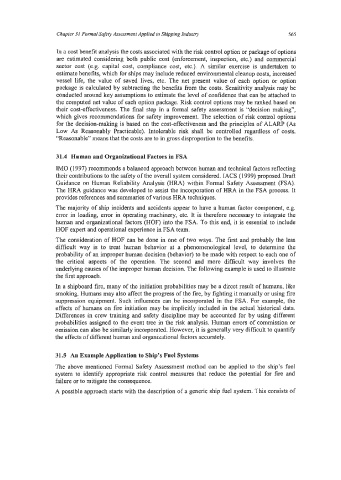Page 589 - Marine Structural Design
P. 589
Chapter 31 Formal Safe@ Assessment Applied to Shipping Industry 565
In a cost benefit analysis the costs associated with the risk control option or package of options
are estimated considering both public cost (enforcement, inspection, etc.) and commercial
sector cost (e.g. capital cost, compliance cost, etc.). A similar exercise is undertaken to
estimate benefits, which for ships may include reduced environmental cleanup costs, increased
vessel life, the value of saved lives, etc. The net present value of each option or option
package is calculated by subtracting the benefits from the costs. Sensitivity analysis may be
conducted around key assumptions to estimate the level of confidence that can be attached to
the computed net value of each option package. Risk control options may be ranked based on
their cost-effectiveness. The final step in a formal safety assessment is “decision making”,
which gives recommendations for safety improvement. The selection of risk control options
for the decision-making is based on the cost-effectiveness and the principles of ALARF’ (As
Low As Reasonably Practicable). Intolerable risk shall be controlled regardless of costs.
“Reasonable” means that the costs are to in gross disproportion to the benefits.
31.4 Human and Organizational Factors in FSA
IMO (1 997) recommends a balanced approach between human and technical factors reflecting
their contributions to the safety of the overall system considered. IACS (1999) proposed Draft
Guidance on Human Reliability Analysis (HRA) within Formal Safety Assessment (FSA).
The HRA guidance was developed to assist the incorporation of HRA in the FSA process. It
provides references and summaries of various HRA techniques.
The majority of ship incidents and accidents appear to have a human factor component, e.g.
error in loading, error in operating machinery, etc. It is therefore necessary to integrate the
human and organizational factors (HOF) into the FSA. To this end, it is essential to include
HOF expert and operational experience in FSA team.
The consideration of HOF can be done in one of two ways. The first and probably the less
difficult way is to treat human behavior at a phenomenological level, to determine the
probability of an improper human decision (behavior) to be made with respect to each one of
the critical aspects of the operation. The second and more difficult way involves the
underlying causes of the improper human decision. The following example is used to illustrate
the first approach.
In a shipboard fire, many of the initiation probabilities may be a direct result of humans, like
smoking. Humans may also affect the progress of the fire, by fighting it manually or using fire
suppression equipment. Such influences can be incorporated in the FSA. For example, the
effects of humans on fire initiation may be implicitly included in the actual historical data.
Differences in crew training and safety discipline may be accounted for by using different
probabilities assigned to the event tree in the risk analysis. Human errors of commission or
omission can also be similarly incorporated. However, it is generally very difficult to quantify
the effects of different human and organizational factors accurately.
31.5 An Example Application to Ship’s Fuel Systems
The above mentioned Formal Safety Assessment method can be applied to the ship’s fuel
system to identify appropriate risk control measures that reduce the potential for fire and
failure or to mitigate the consequence.
A possible approach starts with the description of a generic ship fuel system. This consists of

